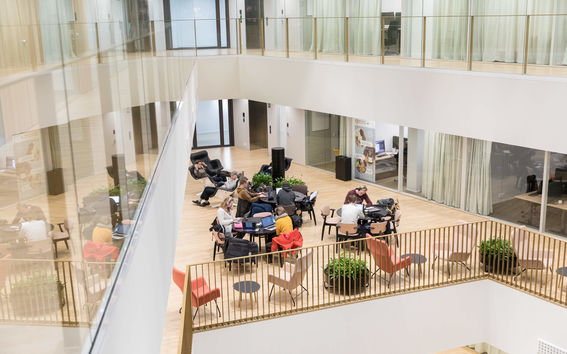Marketing, Master of Science (Economics and Business Administration)
Modern marketers are creative, strategic thinkers who navigate the digital landscape with effortless agility and intuition.

A bibliometric analysis of the research published in the Industrial Marketing Management (IMM) journal over 1971-2017 shows that Aalto University School of Business, and its predecessor Helsinki School of Economics, ranked second in the most productive and influential institutionspublishing in the journal. The University of Manchester came in first while the University of Lancaster placed third.
The IMM journal is by far the leading global publishing institution within industrial and business-to-business marketing.
Altogether business-to-business (B2B) marketing research in Finland fared extremely well, with the country having the third highest rate of total citations after giants like the USA and the UK. In addition to Aalto, Turku School of Economics, Oulu University, and LUT University were active.

As for individual researchers, the contribution from Professor Emeritus Kristian Möller and his colleagues was substantial. They had two papers among the 20 most cited papers and over 25 publications during the period studied, with the majority being from 2000 onwards. Möller captured 11th place in the top 50 leading authors’ table. He is also an Honorary Editorial Board member of the IMM.
‘We focused efforts on understanding the characteristics and building processes of business networks much before networks became the buzz word in strategy,’ Professor Möller says.
‘Another important feature was recognising the fact that various forms of business networks and supplier-customer collaboration were constructed for different strategic purposes, like supplier network orchestration, creation of technological and business model innovations, and customer service networks. Moreover, we tried to dig deeply into the management of network construction and orchestration by identifying actionable sets of management capabilities and company roles for these purposes. And we were ambitious, targeting the best academic forums and journals,’ Möller adds.
A significant aspect for the success of Finnish business-to-business researchers was intense collaboration.
‘We established a nationwide research consortium (ValueNet) among business schools and received funding from the Academy of Finland. There was also fruitful university-business collaboration in several Tekes projects — now a part of Business Finland organization — providing researchers important corporate access. Overall, this collaboration created a critical mass of researchers and research projects which resulted in over new 15 PhD degrees and over 30 academic publications. So, collaboration was essential in overcoming the inherently small size of the Finnish research community and scarcity of the resources of individual universities. Our success was critical also in developing increasing international research networks,’ Möller sums up.
Although the long time period and the large amount of research makes it difficult to define the main results, Möller emphasizes the role of networks.
‘In early 2000s networks were largely regarded as a generic form of organizing, but we showed that strategic networks were used for widely different purposes from demand driven supply systems, for example in the electronics and automotive industries, value-added customer service networks like the S-group system or Amazon, customer solution networks like orchestrating the construction of industrial plants, cruise ships, or complex software systems, to innovation networks targeting such radical innovations like mobile service systems and new technologies, for example, various forms of nanotechnology. Our findings indicated that the value-creation systems underlying these different types of strategic networks varied systematically and we were able to suggest what kind of managerial capabilities and organizational forms best served their construction and orchestration.’
‘These findings are largely valid also for operating and trying to orchestrate ecosystems, which are by and large constructed through interwoven networks. It appears that the social, technological and economic environment is getting increasingly complex, and our latest efforts aim at offering conceptual frameworks and tools for making sense of complex business environments. Firms and public authorities can navigate only through foresight in the current landscape,’ Möller says.
More information:
Professor emeritus Kristian Möller
Aalto University School of Business, Department of Marketing
kristian.moller@aalto.fi
+358 50 383 6190
Research publication information:
Francisco J. Martínez-Lópeza, José M. Merigóc, Juan Carlos Gázquez-Abade and José Luis Ruiz-Reale. Industrial marketing management: Bibliometric overview since its foundation. Industrial Marketing Management (24), 2020, 19-38.
https://www.sciencedirect.com/science/article/pii/S0019850119307308?via%3Dih
Key publications by Möller and co-authors:
Möller, K., & Rajala, A. (2007). Rise of strategic nets - New modes of value creation. Industrial Marketing Management, 36(7), 895-908. Möller, K., & Rajala, A. (2007). Rise of strategic nets - New modes of value creation. Industrial Marketing Management, 36(7), 895-908.
https://doi.org/10.1016/j.indmarman.2007.05.016
Möller, K. (2010). Sense-making and agenda construction in emerging business networks—How to direct radical innovation. Industrial Marketing Management, 39(3), 361-371.
https://doi.org/10.1016/j.indmarman.2009.03.014
Möller, K., & Halinen, A. (2017). Managing business and innovation networks—From strategic nets to business fields and ecosystems. Industrial Marketing Management, 67, 5-22. https://doi.org/10.1016/j.indmarman.2017.09.018
Möller, K., Nenonen, S., & Storbacka, K. (2020). Networks, ecosystems, fields, market systems? Making sense of the business environment. Industrial Marketing Management, 90, 380-399.
https://doi.org/10.1016/j.indmarman.2020.07.013

Modern marketers are creative, strategic thinkers who navigate the digital landscape with effortless agility and intuition.

The Department of Marketing is a thriving and dynamic community of faculty, researchers, staff, and students. The department has earned international acclaim for its ambitious and rigorous research output. We are at the bleeding edge of marketing.